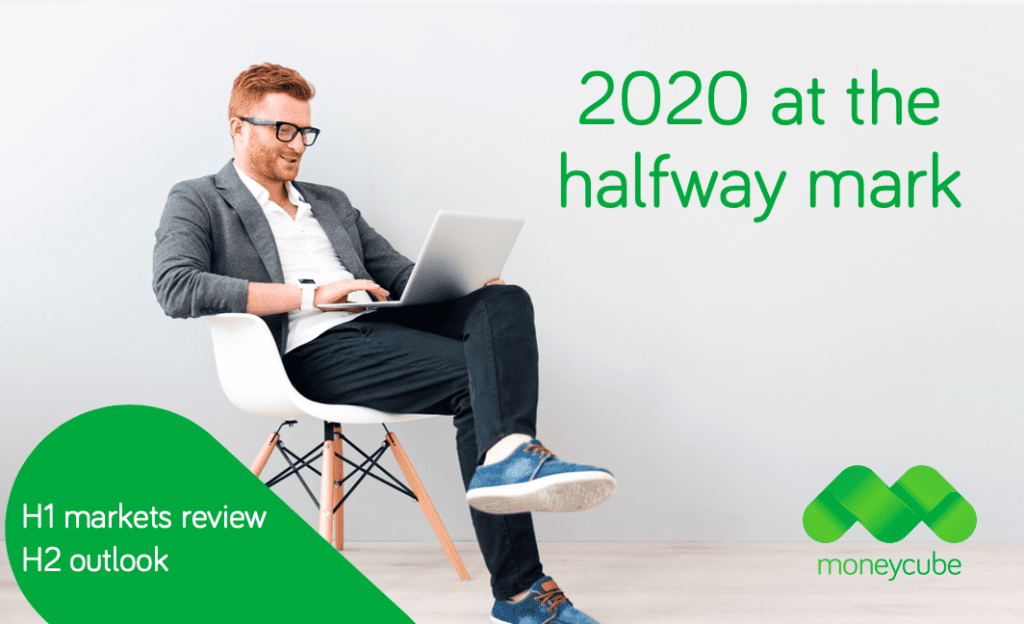If you’re in the habit of checking in on your investments every six months, you’ll have had a pretty uneventful investing year so far. Many equity funds are flat, or even slightly ahead for the six months to the end of June 2020. Read on or jump to our newer midyear review 2021.
But that disguises one of the most dramatic periods for investors in recent memory. As we’ve pointed out elsewhere, everything changed in March.
What happened next was equally remarkable:
Governments around the world announced relief packages worth $10 trillion.
April 2020 was the best month in the markets since 1987.
Markets continued to rally in May and June – but more selectively, as investors began to understand which companies can prosper in a post-coronavirus world, vaccine and treatment hopes rose, and economic activity restarted.
Winners and losers in H1
What’s clear is that from an investment perspective, there are definite winners and losers in the post-coronavirus world.
Tech, healthcare, and ethically-oriented investments have prospered.
Why? Three reasons.
In the short term, unlike many businesses, software companies, and those in the healthcare industry, were able to trade through the lockdowns that affected around a third of the world’s population. In fact, many saw increased demand.
Second, it’s clear that tech and healthcare industries are likely to receive a greater proportion of the money in all our wallets in the coming years – whether that’s equipping employees with the software they need to work remotely, or increasing investment into public healthcare infrastructure.
Lastly, there’s been a sense that we are all in the coronavirus crisis together. Ethical, Social and Governance-oriented funds have invested with that view of life for some time.
That’s why back in March, many ESG funds were less affected by the plummeting oil price and the grounding of airline companies. They simply didn’t hold these stocks. But as the year has worn on, other advantages of ESG investing have become clear. For example, they have generally avoiding in companies with risky supply chains where low-paid workers are at high risk of coronavirus due to their working conditions.
What will drive performance in the second half of 2020?
While almost every share lost out during the great sell-off in March, not all boats have risen since. Here, for example, is the share price performance of Carnival plc, the cruise ship operator. It sank and stayed underwater.

Moneycube expects the trend of winners and losers to continue during the next six months.
So how to pick them?
There’s plenty of reason to think technology, healthcare and ESG investments will continue to outperform.
On the other hand, some sectors will continue to be difficult, for example commercial property, bricks and mortar retail, and oil and gas.
It’s also clear that interest rates will continue to be on the floor. If you’re in search of a meaningful investment return, it’s clear that cash is not an option for the foreseeable future. That’s prompting investors to put their money into other asset classes.
Another major driver of the markets in the coming months is continued government support. Yes, governments worldwide want to wean people off subsidies. But this is being done in a measured way.
The lessons of acting slowly in the global financial crisis have been learned, and there’s little appetite for austerity this time around.
Hold your nerve
The investors who lost out most in the first half of this year were those who sold, crystallised their losses, and missed out on the subsequent recovery.
It’s a reminder hold your nerve when you put your money to work, and to invest only when you have the capacity to ride out short-term market dips.
There’s no doubt there will be continued ups and downs in the months to come. That brings opportunity, but also the need to invest in a considered way.
Time to get active?
It’s often been said that a downturn is when active fund management, rather than index hugging, can really bring a benefit. Is now that time?
Moneycube believes there’s a strong argument for active investing if you’re deploying a lump sum right now, when sorting out winners and losers can make a real difference to your returns.
There are some great examples of actively managed funds that have delivered strong recent results.
Take our favourite tech fund, for example. It’s up a whopping 41% in the first half of 2020. What’s driven that? Holdings in Tesla and Amazon (together over 20% of the fund), and a long list of other winners, have helped. This fund invested in Zoom a year ago.

But above all, this is a fund that holds its nerve. Its manager, Baillie Gifford, has a saying: “Actual investors think in decades. Not quarters”.
When it comes to regular investing (for example into a pension), things are a little different. If you’re in the build-up phase, then choosing funds that will automatically capture a large slice of the entire market is a higher priority.
Whatever your view, it’s more important than ever to engage with your pensions and investments as we enter the second half of 2020.











You must be logged in to post a comment.